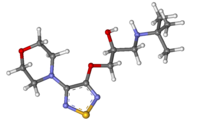Istalol
 |
|
 |
|
| Clinical data | |
|---|---|
| Trade names | Betimol, others |
| AHFS/Drugs.com | Monograph |
| MedlinePlus | a602022 |
| Pregnancy category |
|
| Routes of administration |
By mouth, topical (eye drop) |
| ATC code | |
| Legal status | |
| Legal status |
|
| Pharmacokinetic data | |
| Bioavailability | 60% |
| Metabolism | Liver (80%) |
| Biological half-life | 2.5–5 hours |
| Excretion | Kidney |
| Identifiers | |
|
|
| CAS Number | |
| PubChem CID | |
| IUPHAR/BPS | |
| DrugBank | |
| ChemSpider | |
| UNII | |
| KEGG | |
| ChEBI | |
| ChEMBL | |
| Chemical and physical data | |
| Formula | C13H24N4O3S |
| Molar mass | 316.421 g/mol |
| 3D model (JSmol) | |
|
|
|
|
Timolol is a medication used either by mouth or as eye drops. As eye drops it is used to treat increased pressure inside the eye such as in ocular hypertension and glaucoma. By mouth it is used for high blood pressure, chest pain due to insufficient blood flow to the heart, to prevent further complications after a heart attack, and to prevent migraines.
Common side effects with the drops is irritation of the eye. Common side effects by mouth include tiredness, slow heart beat, itchiness, and shortness of breath. Other side effects include masking the symptoms of low blood sugar in those with diabetes. Use is not recommended in those with asthma, heart failure, or COPD. It is unclear if use during pregnancy is safe for the baby. Timolol is in the non-selective Beta blocker family of medication.
Timolol was patented in 1968 and came into medical use in 1978. It is on the World Health Organization's List of Essential Medicines, the most effective and safe medicines needed in a health system. Timolol is available as a generic medication. The wholesale cost in the developing world is about 0.86 to 2.29 USD per 5 ml bottle. In the United States it costs 25 to 50 USD per month.
In its by mouth form, it is used:
In its eye drop form it is used to treat open-angle and, occasionally, secondary glaucoma. The mechanism of action of timolol is probably the reduction of the formation of aqueous humor in the ciliary body in the eye. It was the first β blocker approved for topical use in treatment of glaucoma in the USA (1978). When used by itself, it depresses intraocular pressure (IOP) 18–34% below baseline within first few treatments. However, there are short-term escape and long-term drift effects in some patients. That is, tolerance develops. It may reduce the extent of diurnal IOP curve up to 50%. IOP higher during sleep. It is 5–10× more potent β blocker than propranolol. Timolol is light-sensitive; it is usually preserved with 0.01% benzalkonium chloride (BAC), but also comes BAC-free. Can also be used in adjunctive therapy with pilocarpine or carbonic anhydrase inhibitors.
...
Wikipedia
